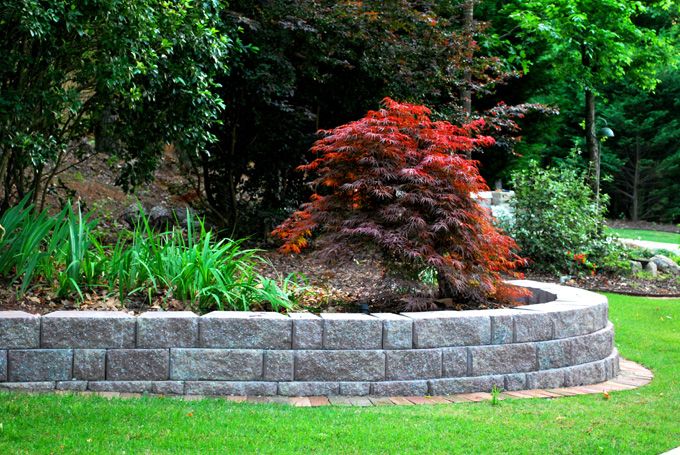
Low Maintenance Landscape Design
I created this page because I hear that phrase a lot. “I want a low maintenance landscape”. Great! So do I, by the way. More hardscape, clean and simple designs, properly chosen plants, fewer plants with more room to grow, longer lasting or permanent mulch and good weed control practices are the ways to achieve “low maintenance” landscapes. Resist the temptation to continue planting “little gems” all over the yard. Research new additions carefully and place them where they can go in their natural form so pruning is unnecessary.
Hardscape Elements
Hardscaping adds design elements that are maintenance free. Over grown hedges can be replaced with fencing arbors or trellises. Retaining walls can permanently stop erosion on hill sides and add low maintenance beauty. Patios and fire pits can add focal points in place of plantings. Island edging with pavers and steel can create sod/island borders that do not have to be edged as often to keep looking clean and defined.
Simple Designs
Clean and simple doesn’t have to be boring. Lay out the landscape with long sweeping curves that are easy to mow. Avoid small, time consuming turf areas that quickly create cluttered areas. Repeat certain plants in several areas to create continuity. Use accent plants or specimens sparingly.
Choose Plants Wisely
Pick a plant based on its characteristics, especially size first. Too many landscape designs are not low maintenance because large plants were placed in small areas. The owners are constantly pruning and trying to control the size. Remove the violators and design a low maintenance landscape by picking the right mature size plant for the space.
Leave Room for Growth
Even a well thought out plan needs space to mature. A plan should be designed to grow 5 years without heavy pruning. Pruning should be done to lightly shape, not reduce size yearly. If you find it necessary to prune most of your plants 2-3 times per year, consider removing the worst violators with an overall, long term plan in mind. Sometimes limited removal without replacement is all that is necessary to clean up the landscape design and create a maintenance free landscape. If plants are intended to grow as individuals, a 4-6’ circle will be needed for the mature plant. Continuous hedges are the exception.
Weed Control
Weed control can be challenging if it has gotten out of hand. Weed control in flower beds and wooded areas, can be a successful DIY effort. Pulling weeds is “almost pointless” when it has gotten out of control. Weed control has 2 steps. Kill & Remove! First you must kill the undesirable plant. Second you must keep it from returning. Weeds grow from roots and seed. Pulling weeds may not remove all roots. Mature weeds have already dropped seeds so they will be back. Spraying “round up” like weed killer will kill the foilage and roots if applied correctly.
SEED control is more complicated. There are several different germination seasons for weeds because they all have favorite ground temperatures for germination. Pre-emergence like “Preen” ( chemicals designed to keep seeds from germinating) work well but must be present when a particular weed starts to germinate. My suggestion is to be diligent with regular spraying for an entire year. Spray “round-up” type weed control often enough to never let the weed mature and produce seed. Some weeds will grow more quickly than others. Only pull weeds when the ground is soft from rain so you get “All” the roots.
Killing Vines?
Two methods come to mind. Mechanical and chemical. Notice I did not say hand labor. In many cases, the desired results are best accomplished by clearing the area with a bobcat for larger spaces or weed whacker/string trimmer with a blade in smaller ones (not recommended for Poison Ivy). DO NOT BURN OFF VINES. A hot enough fire to burn vines will likely catch other things on fire & the smoke/steam created from burning some vines can create EMERGENCY ALLERGIC REACTIONS that put people in the hospital. Most vines will grow back from the roots after burning anyway.
Back to the “right way.” Consider the finished look. Once the vines or weeds are gone what goes there? Sod often replaces large beds so using a bobcat is the most efficient approach. Chemical treatment is a great permanent method but can be slow going. Killing Poison Ivy, Wysteria, or English Ivy will require 3-4 round up applications at higher mix concentrations. These applications should be made in dry conditions after the morning dew has dried and on a sunny day when possible. By the most concentrated product you can find and mix at the highest recommended rate when killing poison ivy and other vines. The more shade the longer the process and possibly the more concentrated the application will need to be.
Lawn weed control follows the same process. Kill the weed and roots and keep seeds from germinating. Extreme care must be given in turf areas to keep from harming the grass while. still killing weeds. Pre-emergence is still the best way to control weeds in the long term. As stated previously, there are different seasons for different weeds (cool & warm) so treatments scheduled throughout the calendar year is the best way to control lawn weeds. I pay a service to help with aspect of weed control at my home but I take care of planting beds and wooded areas.
One last thought on weed control. We all tend to want a neat look so we try to “over control” our landscape environment. Decide just how much you really want to maintain. Establish borders of “manicured” vs. natural. Define the difference if you must with clean sod edges and even border plantings. The natural areas should be left natural. DO NOT remove the natural weed barrier of leaves and mulch from areas to make it look neater. This will only create erosion and promote weed growth.
Clearing Underbrush
If you have natural areas that you want to look better or less populated, Clearing the under brush will open up views and provide a cleaner natural area. I suggest taking a slow, long term approach. First identify the desirable plants and trees. There are usually several native species in these areas (especially larger estate lots) that you may want to keep. Dogwoods, red buds, native magnolias and hollies If left to grow naturally can be nice natural touches. Mark and remove diseased and ugly plants & trees first. Next decide on less popular trees like sweetgums or pines. Simply cutting trees down does not insure they are gone. Trees like sweet gums, maples and hollies will grow back from the roots so painting round up on freshly cut stumps further insures permanent removal. We can help you through the process of identifying and removal and are happy to provide these services.
Posted on behalf of
215 Rebecca Ct
Fayetteville, GA 30215
Phone: (770) 616-3194
Burt@landscapeinn.com
Monday - Friday 8:00 AM – 5:00 PM
